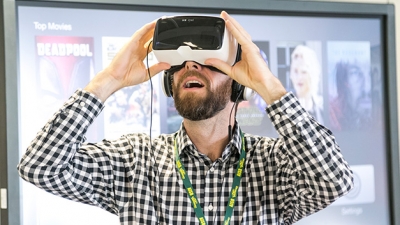At the American International School of Bucharest, the grade 4 students inquired into ways humans express ideas, feelings, and values and developed an appreciation for human creativity and the aesthetic. The goal was for students to develop a deeper understanding of architectural structures and how architect’s intended to express values and feelings.
As we began to unpack this unit, we realized that using traditional approaches to reaching the content provides us with some challenges. Mr. Clark Masters, 4th- grade class teacher, Ms. Ellen Prefontaine, extended learning specialists, and David Carollo, Technology Learning Coordinator, using a co-teaching model, set out to meet those challenges.
I interviewed Mr. Clark and Ms. Prefontaine regarding the challenges and technolgy tools used in this unit:
What were your challenges with this lesson using traditional methods of engaging students and executing?
One challenge that we had was that we needed our students to be able to learn about and later identify different architectural features. Although there are many local examples of great architecture in Bucharest, these were limited to styles that are predominantly European. We wanted to be able to expand our students’ understanding to different time periods as well as different examples from other parts of the world. Another challenge was ensuring students had access to examples of architectural structures across various subjects.
Although our primary exploration was through learning engagements for our UOI, this unit had many connections to other disciplines, especially Math and Art. We needed students to be able to access what they were learning in UOI so they could connect it to what they were learning about how people express ideas through architecture or how architects use their knowledge of shape and space to design iconic structures. ~ Mr. Clark
To increase the breadth and depth in which students can access the content we used a various technology tools. These tech tools allowed students to go deeper into the content to observe and create architectural structures in an immersive environment. This was much more engaging, and students were able to make connections otherwise difficult to obtain using traditional methods.
Using Virtual Reality (VR), students visited, for example, La Sagrada Family in Barcelona, Spain. Utilizing “Google’s Pegman”, students were able to get a profound perspective of this amazing structure. You can drop Pegman anywhere, and your perspective will change. To go even further, we used a Virtual Reality headset and a Google App to enter La Sagrada Familia to truly get an immersive, personal experience. Other students were able to track what the student was experiencing on the Interactive TV which created meaningful discussions and exciting discoveries.
How did technology help you enhance student engagement and students access to the content/concepts?
- Google Street View – Students, were able to find examples of different architectural styles and structures from around the world. ~ Mr. Clark
- VR Headset – Students were able to “visit” a far wider range of structures than they would have been able to locally. They were also able to see how similar architectural features might be used differently during different time periods and in different parts of the world. ~ Mr. Clark
- Apple TV – All students were able to participate in a “visit” thus helping us utilize our time more efficiently.
- OneNote Classroom – Students were able to save their research in a platform that allowed them to access it easily in different parts of the school and at home. OneNote also allowed teachers to create scaffolds and guide the students’ inquiry. It was a quick and efficient system for delivering materials and content to students. ~ Mr. Clark
The OneNote supported this link. By inserting a tab for Extended Learning directly into each student’s Unit OneNote, this allowed all students and teachers involved to add to the thinking and progress of the learning. Everything was integrated and did not feel separate. The fact that students and I could refer to the actual work and tasks they had been involved in in the classroom allowed for clear integration. ~ Ms. Prefontaine - https://www.tinkercad.com/ (3D Modeling) – Tinker Cad supported each student’s engagement because they were enthusiastic about actually creating their structure utilizing the architectural features they were learning. The program allowed students to build a structure that worked within the time limits we had. Tinker Cad was an excellent tool that allowed the students to visualize and manipulate 3-D structures. This would not have been accessible on a piece of paper. ~ Ms. Prefontaine
- Next time I would use this to support the geometry lessons in math so that students could create their models of 3D shapes. I would also consider having students design their assessment structures using this program first, so they had a “blueprint” for what they wanted to make. ~ Mr. Clark
How might using this technology help you engage with students that otherwise would be difficult to do without the technology.
- The opportunity to take virtual field trips opens up a wide range of possibilities for the class. For example, we have another unit where students are learning about the physical changes to the Earth. Virtual reality gives students a chance to visit landforms that they might not have seen before. It also can give them a greater appreciation for the scale of some of these landforms in a way that photos couldn’t. ~ Mr. Clark
- OneNote classroom also enhances and extends collaboration across the curriculum. Teachers can differentiate learning engagements, so they fit the needs of students better. ~ Mr. Clark.
In conclusion, we have reached a world of possibilities. Using available technology, we were able to design tasks that had a significant impact on student outcomes. This required a team approach and careful planning. The results allowed for new tasks that were previously inconceivable and gave students opportunities for wider reach and a deeper understanding of the concepts.

